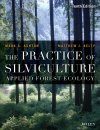About this book
It has been 20 years since the publication of the ninth edition. Much work has been done since then and many new resource issues have become relevant to forests and forestry. For example – biofuels, ecosystem services, surface drinking water supplies, urban and community greenspace, forest carbon, fire and climate, land intensification versus a more extensive but de-intensive applications of silviculture for societies for obtaining societies goods and services.
In addition silvicultural systems have become much more sophisticated and complex in application – particularly with a focus on multi-aged silviculture. There have been recent paradigm shifts toward managing for more complex structures and age-classes for integrated and complementary values – wildlife, water and open space recreation.
The tenth edition of this premier resource has been signficantly revised and expanded, and now features full colour throughout. The bibliography has been updated, new photographs, tables and figures have been added, and boxes are included in each chapter to provide greater detail on particular silvicultural treatments and examples of their use. Covering a wide range of topics and resource issues facing the forester or resource professional today, this is the most expansive book on silviculture.
Contents
Part One: Introduction to silviculture
Chapter 1 The history and philosophy of silviculture
Chapter 2 Silviculture and its place in managing current forests and woodlands
Part Two: Ecological foundations of silviculture
Chapter 3 Ecological site classification, stands as management units, and landscape-scale planning
Chapter 4 Stand dynamics: the ecology of forest succession
Chapter 5 Ecology of regeneration
Part Three: Methods of regeneration
Chapter 6 Development of silvicultureal systems and methods of regeneration
Part 3A: Natural regeneration methods
Chapter 7 Site treatments
Chapter 8 Natural regeneration: the clearcutting method
Chapter 9 Natural regeneration: the seed-tree method
Chapter 10 Natural regeneration: the shelterwood method
Chapter 11 Natural regeneration: multi-aged systems (irregular seed-tree and shelterwood methods)
Chapter 12 Natural regeneration: the coppice method
Chapter 13 Natural regeneration: selection method
Part 3B: Methods based on artificial regeneration
Chapter 14 Species selection and genetic improvement
Chapter 15 Nursery, planting, and seeding techniques
Chapter 16 The arrangement, composition and methods of planting
Part Four: Post-establishment (intermediate) treatments
Chapter 17 Tree and stand growth
Chapter 18 Post-establishment tools in silviculture
Chapter 19 Pruning methods and applications
Chapter 20 Release operations in seedling and sapling stands
Chapter 21 Methods of thinning
Chapter 22 Quantitative guidelines for stand density management
Part Five: Silvicultural considerations for managing all forests
Chapter 23 Conservation management practices
Chapter 24 Silviculture for wildlife habitat
Chapter 25 Silvicultural applications to forest retoration: rehabilitation and reclamation
Chapter 26 Approaches and treatments to maintaining healthy forest ecosystems
Chapter 27 Managing forest carbon in changing climates
Part Six: Silvicultural applications for different land uses
Chapter 28 Ecosystem management: managing public natural forests for multiple values
Chapter 29 Application of silviculture to watershed management
Chapter 30 Industrial timber management
Chapter 31 Application of silviculture to agroforestry
Chapter 32 Application of silviculture to uran ecosystems and the urban-rural interface
Chapter 33 Synthesis
Glossary
Index
Customer Reviews


































